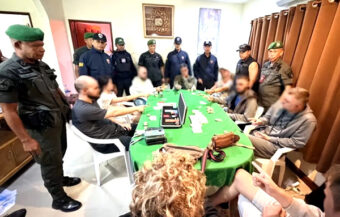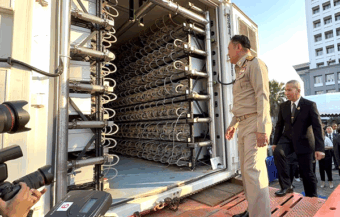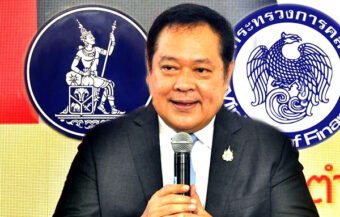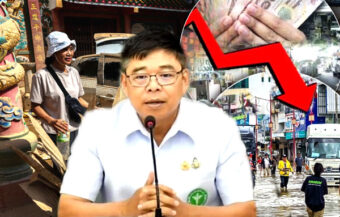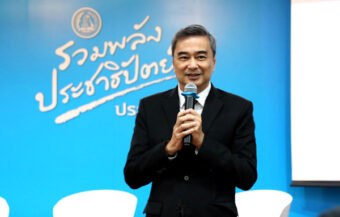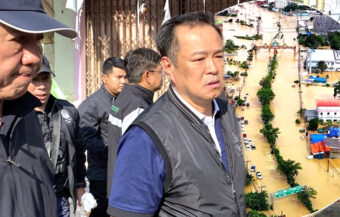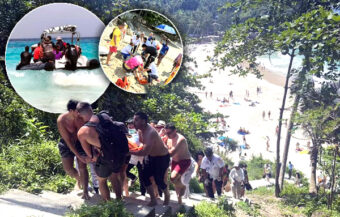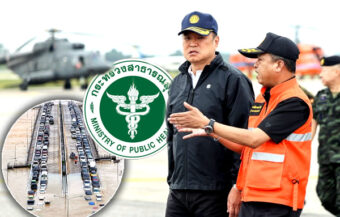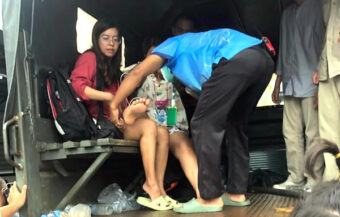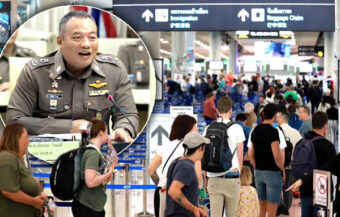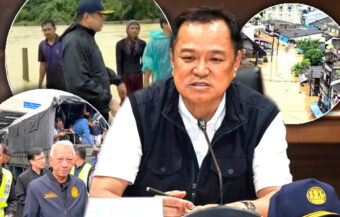Trump to oversee historic Thai-Cambodian deal as PMs Anutin and Hun Manet agree to jointly map border with LiDAR, remove heavy weapons, clear mines, and launch a coordinated campaign against fraud, scams, and cross-border crime along the tense frontier.
Thailand’s PM Anutin Charnvirakul and Cambodia’s PM Hun Manet will sign a landmark declaration on Saturday, unveiling bold new measures. For the first time, officials will jointly map the border using LiDAR, enabling precise surveys and restoring displaced markers. The deal also commits both nations to remove heavy weapons, clear mines, and launch a joint campaign against transnational fraud and scams. US President Donald Trump will witness the signing alongside ASEAN Chairman and Malaysian PM Anwar Ibrahim, underlining global support. Officials say the agreement ushers in a new era of cooperation, trust, and high-tech diplomacy along a tense, decades-old frontier.
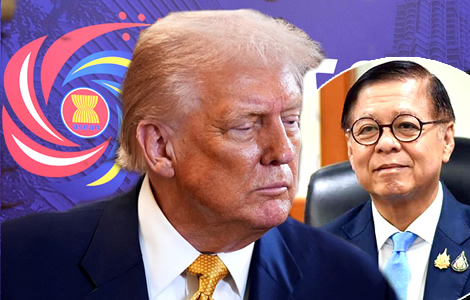
U.S. President Donald Trump will witness the signing of the Declaration of Thai-Cambodian Relations on October 25 in Malaysia. This historic event will take place during the ASEAN Summit in Kuala Lumpur, and Malaysian Prime Minister Anwar Ibrahim, as ASEAN Chair, will also attend. The signing represents a major step toward resolving decades-long disputes along the Thai-Cambodian border. Moreover, it aims to ease tensions along the shared frontier, which has seen intermittent clashes for years.
Thai Foreign Minister Sihasak Phuangketkeow confirmed that the declaration will be signed by both prime ministers during the ASEAN Summit.
He emphasised that the agreement will focus on withdrawing heavy weapons, clearing landmines, and jointly combating transnational crime. Furthermore, Sihasak said all measures will follow a detailed step-by-step action plan.
Thai and Cambodian PMs to sign declaration on border, weapons removal, landmines and scam centres
The announcement follows progress at the Special Meeting of the Cambodian–Thai Joint Commission on Demarcation for Land Boundary (JBC) in Chanthaburi on October 21–22. During the meeting, officials agreed to adopt neutral language for disputed land in the Ban Nong Chan–Ban Nong Ya Kaew area. Instead of using terms like “relocate, remove, or destroy,” the phrase “adjust land holding/possession” will be employed. This adjustment signals a new willingness for compromise.
Former Thai Ambassador Prasas Prasasvinitchai and Lam Chea, Cambodia’s Minister in charge of the State Secretariat of Border Affairs, co-chair the Joint Boundary Commission. On October 22, they signed the Agreed Minutes of the Chanthaburi meeting. Prasas described the discussion as “straightforward and constructive,” while Benchamin Sukanjanajtee, Director-General of Thailand’s Department of Treaties and Legal Affairs, noted it was the first JBC meeting to issue a joint statement. Consequently, the statement highlights both countries’ commitment to accelerating border demarcation and easing frontier tensions.
Officials also reached agreements on boundary pillars. Fifteen pillars will be restored to their original positions, and three submerged pillars will be repositioned once both sides reach consensus. Additionally, both sides agreed to use LiDAR technology for faster, more accurate mapping. This step demonstrates a modernised approach to border management.
Joint commission agrees to use LiDAR and restore boundary markers. Major progress on border dispute
LiDAR is a technology that uses lasers to measure distances on an object or surface. Notably, the system is 3D compliant and represents a commitment to objective assessment.
Therefore, Thai and Cambodian officials should be able to resolve border disputes that have lingered for decades over old-fashioned map scales.
The LiDAR system works day and night and is known for its accuracy.
Thai Defence Minister Gen. Natthaphon Nakphanich said Thailand and Cambodia will conduct joint surveys for the first time. Temporary boundary markers will be placed between pillars No. 42–47 in Sa Kaeo Province. Importantly, Gen. Natthaphon stressed these markers are for survey purposes only and do not affect Thailand’s territorial rights. Furthermore, he stated that border fence construction will proceed solely in clearly established areas.
The temporary markers symbolise increased trust and cooperation between both countries. Gen. Natthaphon described the initiative as an important confidence-building measure. It reflects a shift from past confrontations to proactive collaboration. Both sides now aim for transparency and strict adherence to international standards in border work.
Thai officials outline detailed action plan addressing Cambodian encroachments and security plans
On October 23, 2025, at the King Chulalongkorn Memorial in Bangkok, Minister Sihasak elaborated on the upcoming signing. He noted that the Thailand-Cambodia General Border Committee (GBC) had settled most of Thailand’s priorities.
Agreements include withdrawing heavy weapons, clearing landmines, and suppressing transnational crime. Furthermore, the GBC developed a detailed step-by-step plan to ensure implementation.
The plan also addresses Cambodian encroachments on Thai territory. Sihasak explained that the Joint Boundary Commission will determine remedies for disputes at Ban Nong Ya Kaeo and Ban Nong Chan in Sa Kaeo Province. Officials will carefully examine encroachment areas and decide on corrective measures. Consequently, both countries aim to resolve these disputes peacefully and systematically.
Sihasak expressed confidence that the Thai and Cambodian prime ministers will sign the declaration at the ASEAN Summit. The ceremony will be witnessed by U.S. President Donald Trump, Malaysian Prime Minister Anwar Ibrahim, and leaders of other ASEAN member states. Moreover, the declaration will be accompanied by an action plan outlining specific steps, responsibilities, and timelines.
Action plan includes weapons withdrawal landmine clearance and efforts to combat transnational crime
The action plan details the withdrawal of heavy weapons, landmine clearance, and measures against transnational crime. Sihasak emphasised that clear timelines and accountability mechanisms are included. Furthermore, he stressed that the declaration signifies a new era of trust and cooperation between Thailand and Cambodia.
The Thai-Cambodian border has long been a source of tension, with recurring disputes over land and resources. Past demarcation efforts were delayed by disagreements over language, technical mapping, and territorial claims. However, the Chanthaburi JBC meeting marked a breakthrough. Both sides demonstrated readiness to compromise, use neutral terminology, and adopt modern survey technologies.
LiDAR technology will allow officials to generate precise maps of disputed areas. Consequently, the technology will reduce delays and potential confrontations. Officials believe it will significantly accelerate the resolution of remaining border issues.
Joint field surveys represent another step toward collaboration. Thai and Cambodian officials will work together to place temporary markers and replace permanent pillars. Gen. Natthaphon emphasised that these activities will build trust and prevent misunderstandings. Moreover, they will help ensure that all border work is conducted transparently and peacefully.
Analysts call declaration a diplomatic breakthrough with wide regional and international significance
Analysts view the upcoming declaration as a diplomatic breakthrough. It formalises agreements reached in previous meetings and establishes a clear framework for ongoing border management. Furthermore, it integrates security, technical, and legal measures, reducing the likelihood of future disputes.
ASEAN observers highlighted the symbolic importance of the signing ceremony. With U.S. President Donald Trump attending, the declaration will attract global attention. Moreover, it emphasises ASEAN’s role in promoting regional conflict resolution. The presence of multiple heads of state underscores strong international support for bilateral cooperation.
Thai and Cambodian officials stressed the importance of maintaining momentum. Follow-up meetings will monitor the implementation of the action plan. Additionally, both sides confirmed that the process will remain transparent and subject to ongoing review.
Declaration expected to strengthen regional security and foster economic development along the border
The declaration also carries broader regional significance. By providing a clear framework for border management, both countries can focus on issues like cross-border crime, human trafficking, and illegal logging. Joint efforts are expected to enhance regional safety and foster economic development.
Undoubtedly, the Declaration of Thai-Cambodian Relations represents a historic milestone. It reflects years of negotiation, technical collaboration, and high-level diplomacy. Moreover, it creates the framework for peaceful coexistence, joint security and coordinated development along the border.
PM asks top minister for explanation as ex official claims Hun Sen started war to protect his scam centre industry
Anutin faces stiff foreign policy test over October 10 deadline and President Trump’s demands for peace
Cabinet meets after Cambodian ceasefire. Acting PM Phumtham spoke later with Trump for 30 minutes
Both countries have committed to transparency, adherence to international standards, and trust-building measures. Finally, officials described the process as constructive and forward-looking, signalling optimism that past conflicts can now be resolved through diplomacy, compromise, and mutual respect.
Of course, this is a blueprint. Indeed, it significantly improves the basis for resolving the long-running border issues. However, cynics suggest that the present Thai-Cambodian conflict was linked to the threat to the scam compounds presently generating huge revenues for the Hun Sen regime. That issue has not been tackled despite the high hopes for Saturday’s document.
Join the Thai News forum, follow Thai Examiner on Facebook here
Receive all our stories as they come out on Telegram here
Follow Thai Examiner here
Further reading:
High powered, secretive meeting chaired by PM agrees robust action against Cambodian networks
Thailand and Cambodia face danger from ‘Dragon Head’ the Chinese mafia leader behind the scams
Cyber police and Money Laundering agency seek UK and US co-operation targeting Cambodian networks
United States, South Korea and United Kingdom act against Cambodian scam industry with Thai tie-ins
Ben Smith affair & allegations of links to Cambodian scam centres continues to rage in parliament
Defiant Rangsiman Rome warns he’s not just fighting a defamation case but for the future of Thailand
Ben Smith money fixer to the elite in Thailand lines up ฿100M defamation case against Rangsiman Rome



